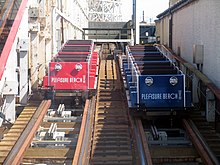Roller coaster with multiple lanes
In a roller coaster with several lanes , several routes are traveled within a roller coaster system . There are different types: racing roller coasters, dueling roller coasters, Möbius roller coasters and independently operating multiple systems.
Racing roller coaster
A racing roller coaster (German: Renn-Achterbahn) is a roller coaster with several lanes that run largely parallel and in which the start of the ride is coordinated so that the vehicles deliver a race.
In most cases, systems are built with two lanes. John A. Miller built at least two three-lane wooden roller coasters in the 1930s . Likewise, Steeplechase , Pleasure Beach Blackpool has three lanes, and a steeplechase railway on Coney Island had eight lanes at the beginning of the twentieth century.
Examples
- American Eagle , Six Flags Great America - wooden roller coaster
- Windjammer Surf Racers , formerly Knott's Berry Farm - steel roller coaster
- Gemini at Cedar Point - steel roller coaster
Dueling roller coaster
A dueling roller coaster (German: Dueling roller coaster) is a type of roller coaster consisting of two roller coasters with a similar route that are directly next to each other.
In contrast to the racing roller coasters, the routes are largely not parallel. The routes of both railways are about the same length and the departure of the trains is coordinated. The station and lift hill are mostly parallel to each other, but after the lift the lifts take different routes back to their stations. Aligned inversions and the narrow routing create the feeling as if the tracks are about to collide. This leads to an apparent “duel” between the two tracks.
Examples
- Cop Car Chase , Movie Park Germany - the only dueling roller coaster based in Germany was demolished in 2006.
- Dragon Challenge , Universal's Islands of Adventure in Orlando , Florida - the world's only dueling Inverted Coaster
- Lightning Racer , Hersheypark in Hershey , Pennsylvania - wooden roller coaster
- Gwazi , Busch Gardens in Tampa , Florida - wooden roller coaster
Möbius roller coaster
The Möbius roller coasters are a special form of racing or dueling roller coasters . The route is like a Möbius strip , there is only one infinite route instead of two independent ones, the vehicles reach the other station at the end of the completed lap. Möbius roller coasters are rarely built, and the Roller Coaster Database only lists a few.
Examples
- Grand National , Blackpool Pleasure Beach - wooden roller coaster
- Racer , Kennywood - wooden roller coaster
- Max Adventures Master Thai , Mirabilandia - steel roller coaster
Multiple system
Some roller coasters are built as multiple systems without the lanes running parallel in any particular way or interacting with one another in any other way. In most cases, the main aim is to increase visitor capacity.
Examples
- Matterhorn Bobsleds , Disneyland Park
- Winja's Fear & Winja's Force , Phantasialand - double spinning coaster from Maurer Söhne
- Various Wilde Maus double systems, for example Speedy Bob in Bobbejaanland - formerly two mirror-image Wilde Maus roller coasters with a parallel lift hill , one of the lanes was dismantled in 2008
Individual evidence
- ^ David Bennett: Roller Coaster: Wooden and Steel Coasters, Twisters and Corkscrews , Edison, Chartwell Books, New Jersey, 1998, ISBN 0-7858-0885-X
- ↑ Möbius roller coasters in the RCDB



